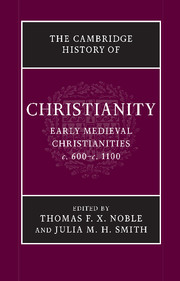Book contents
- Frontmatter
- Introduction: Christendom, c. 600
- Part I Foundations: Peoples, Places, and Traditions
- Part II Christianity in Confrontation
- Part III Christianity in the Social and Political Order
- 12 The Christian church as an institution
- 13 Asceticism and its institutions
- 14 Law and its applications
- 15 The problems of property
- 16 Ideas and applications of reform
- 17 Churches in the landscape
- Part IV Christianity as Lived Experience
- Part V Christianity: Books and Ideas
- Conclusion: Christendom, c. 1100
- Bibliographies
- Index
- References
14 - Law and its applications
from Part III - Christianity in the Social and Political Order
Published online by Cambridge University Press: 28 March 2010
- Frontmatter
- Introduction: Christendom, c. 600
- Part I Foundations: Peoples, Places, and Traditions
- Part II Christianity in Confrontation
- Part III Christianity in the Social and Political Order
- 12 The Christian church as an institution
- 13 Asceticism and its institutions
- 14 Law and its applications
- 15 The problems of property
- 16 Ideas and applications of reform
- 17 Churches in the landscape
- Part IV Christianity as Lived Experience
- Part V Christianity: Books and Ideas
- Conclusion: Christendom, c. 1100
- Bibliographies
- Index
- References
Summary
The term “law” has a deceptive consistency. It may be said to result from “a particular political ideology or even cosmology.” Yet even within a given tradition, geographical setting, or institutional context, its applications and meanings are far from consistent. To study law in history is to study change. The subject of this chapter, the law of the early medieval Church, or canon law, turns out to be a disparate and lumpy mix, resistant to categorization in terms of later-medievel legal assumptions and modern ones alike. A canon in Greek is literally a yardstick, hence, a rule. The term stuck, in west as well as East. By 600, the canons issued by the great councils of the fourth and fifth centuries were widely regarded as authoritative. Thereafter, in the various provinces and kingdoms of the early medieval West, no single authority issued or taught or interpreted the rules of canon law. Bishops assembled in councils made law from time to time, legal collections continued to be made and circulated on private and local initiatives, and law was applied by bishops acting as judges. The situation was not so different in the East, and scholars nowadays are alive to the prevalence there, despite the concentration of evidence emanating from Constantinople, of provincial activity and diversity. In both East and West, canon law and secular law were associated in practice, and secular and ecclesiastical concerns overlapped in imperial legislation. For the Church, as for secular rulers in the West, the Theodosian Code (438) remained an occasional reference point for much of the period covered in this chapter, while in the East, the Justinianic Code (534) remained the basis of canon and secular law throughout.
- Type
- Chapter
- Information
- The Cambridge History of Christianity , pp. 299 - 326Publisher: Cambridge University PressPrint publication year: 2008
References
- 3
- Cited by



